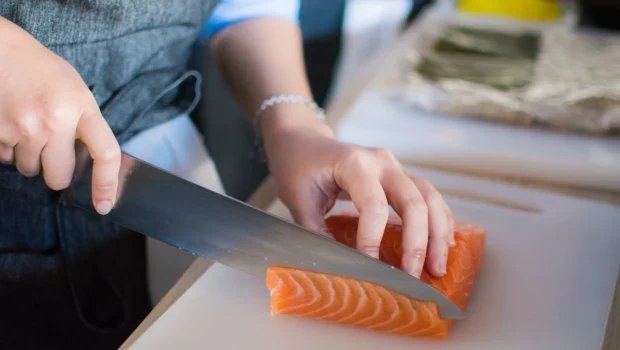Top 6 Things to Keep in Mind Before Buying a New Knife in our Both Cultures
In France and the United States alike, the act of purchasing a new knife is an exciting and fulfilling endeavor, regardless of your culinary skills or outdoor pursuits. Both cultures appreciate the artistry and functionality of a well-crafted blade. Whether you’re indulging in the rich culinary traditions of France or exploring the diverse American culinary landscape, selecting the perfect knife is a testament to the shared passion for exceptional tools in the pursuit of culinary excellence. So, whether you find yourself in a Parisian kitchen or a bustling American eatery, remember that the joy of acquiring a new knife unites these two cultures through their appreciation for craftsmanship and the pleasure of preparing exceptional meals.
Buying a new knife can be an exciting and rewarding experience, regardless of your level of culinary expertise or if you enjoy the great outdoors.
To ensure you choose the finest alternative, however, you must take into account a few factors given the abundance of available choices. Notably, using the right knife can enhance your culinary abilities, make outdoor activities more enjoyable, or simply be beneficial in everyday situations.
This tutorial will review the essential factors to consider when purchasing a new knife. We’ll give you a full overview to help you make an informed decision, from assessing your needs and preferences to evaluating the different parts of a knife.
You may choose a knife that suits your needs, feels comfortable in your hand, performs well, and lasts a long time by considering these factors.
1. Handle

The handle of a knife is incredibly essential because it determines the grip of the knife. Fortunately, you may find various kitchen knives that are available in a monthly knife box with a unique handle.
The handle is roughly classified into three types:
Wooden Handles Knives
Wooden handles are regarded to provide the best grip, but they are difficult to maintain. They also have a higher brittleness and absorb germs.
Plastic Handles Knives
Plastic knives are more durable and last longer. They are also simple to clean and require little upkeep. Notably, they are slick and give little grip, resulting in slips and cuts that must be avoided.
Composite Handles Knives
Composite knives are the third type. Because these handles are composed of wood and bonded with plastic resin, they provide the benefits of both wood and resin. No wonder most chefs prefer and recommend composite blades, which do not allow the tool to collect bacteria, making them cleaner and more hygienic.
2. Sharpness

The least significant element to consider before purchasing a knife set is the sharpness of the blades. Sharper blades are safer if you chop properly because you won’t have to slice as hard and increase your risk of slipping. Sharp blades are also low-maintenance because they can be sharpened less frequently. Damascus knife sets are known for their exceptional edge retention, meaning they stay sharp for longer periods.
3. Using Them Should Be Easy
You want knives that feel comfortable in your hand and are simple to use – user experience is extremely important. With a convenient knife, cutting meats, vegetables, fruits, and other types of food should be straightforward, and your experience should always be positive.
4. Knife Material
Modern kitchen knives are frequently made of stainless steel, and for a good reason—it is durable, robust, and easy to sharpen. Some more expensive blades employ carbon steel instead of stainless steel since it is stronger and more resilient.
Another is a ceramic material. Ceramic knives are less prevalent, despite being extremely sharp and lightweight. Because they are difficult to sharpen at home, they can also require professional assistance.
5. Cost Matters
Investing in high-quality knives that will last for many years is a smart idea if you spend much time in the kitchen and do a lot of your cooking. Knives can be expensive up front, but if they are well-made, keep sharp, and make cooking easier, you will quickly forget the cost.
A decent chef knife, for example, can cost more than $200, but if it’s used daily and has some major obligations to fulfill, that investment will rapidly pay for itself.
6. Weight And Balance

You want knives with weights that make them easy to use in all situations. Using a well-balanced knife feels natural and provides a full range of motion for each cut.
Parts Of a Knife

1. Handle
The handle of your knife is vital for three reasons: balance, grip, and comfort.
Look for handles constructed of natural hardwoods or solid polymer synthetics for balance. Either of these materials also has a slip-resistant grip, which helps to reduce accidents.
However, the comfort of a knife handle is almost entirely a matter of personal preference. If possible, test a range of knife handles in person to see which ones are most comfortable for your hands.
2. Bolster
A knife’s bolster is located between the blade and the handle. It can give weight and protection to a knife while preventing your lead finger from slipping into the blade’s back edge.
Significantly, a full bolster adds the most weight and safety, but it is more challenging to employ your entire blade. This is why we prefer a half bolster, often a diagonal bolster. It provides some protection and just enough weight for a good balance while allowing you to use the entire length of your blade.
Knives without bolsters forsake the extra metal entirely, resulting in a lightweight blade with exceptional mobility but no protection.
3. Tang
A knife’s tang describes how far the blade’s metal reaches into the handle.
Knives with a full tang are constructed from a single piece of steel that extends from the tip of the blade to the butt of the handle. At the expense of a larger weight, this gives the most sturdy and long-lasting construction of any knife design.
Semi-tang knives have steel that extends just partially into the handle. This permits the knife maker to create a lighter tool at the expense of some durability. Knives with no tang are almost always the least expensive and least durable. We do not advocate purchasing a knife with no tang since it will break at the handle junction.
Bottomline
Considering these variables, you may confidently choose a new knife that meets your demands, is durable, and improves your cutting and slicing experiences. Remember that investing in a high-quality knife is a long-term move that will pay you.
Header photo credit: https://www.pexels.com/photo/person-slicing-meat-on-white-chopping-board-1409050/

















Fantastic read! This article does an excellent job of breaking down what smart homes are and how they’re transforming modern…